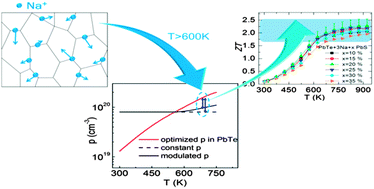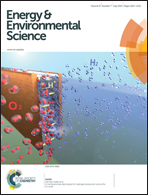Superior thermoelectric performance in PbTe–PbS pseudo-binary: extremely low thermal conductivity and modulated carrier concentration†
Abstract
Lead chalcogenides are dominant thermoelectric materials in the medium-temperature range due to their highly favorable electronic band structures and low thermal conductivities. An important system is the PbTe–PbS pseudo-binary, and its low thermal conductivity originates largely from the coexistence of both alloying and nanostructuring through phase-separation. To better understand the competition between the alloying and phase separation and its pronounced effects on the thermoelectric performance in PbTe–PbS, we systematically studied, via transmission electron microscopy (TEM) observations and theoretical calculations, the samples of Spark Plasma Sintered (SPSed) 3 at% Na-doped (PbTe)1−x(PbS)x with x = 10%, 15%, 20%, 25%, 30% and 35%. The highest figure of merit, viz., ZT ∼ 2.3 was obtained at 923 K, when the PbS phase-fraction, x, was 20%, which corresponds to the lowest lattice thermal conductivity of the series. The consistently lower lattice thermal conductivities in the SPSed samples as compared with the corresponding ingots originates from the mesostructured nature of the former, which contributes significantly to their superior ZT. We also studied the onset of carrier concentration modulation at ∼600 K, which leads to the observed saturation of electrical transport properties due to the diffusion and re-dissolution of excessive Na into the PbTe–PbS matrix. This carrier concentration modulation is equally crucial to achieve very high power factors (up to 26.5 μW cm−1 K−2 at 623 K) and outstanding thermoelectric performances in SPSed PbTe–PbS binaries.


 Please wait while we load your content...
Please wait while we load your content...